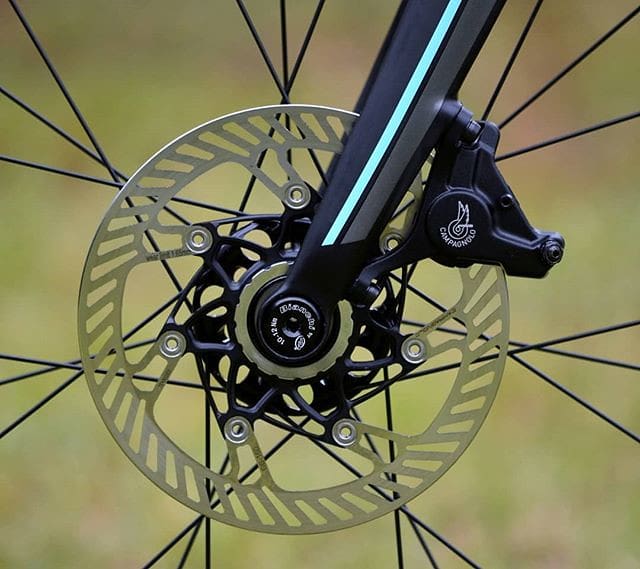Are You Fully Selling Road Disc Benefits?

Disc brakes for road bikes have finally reached a tipping point in terms of market acceptance. The most surprising thing is not so much that this has actually happened, but by how many years road bikes have lagged behind mountain bikes. Some of these delays have been caused by the very slow and cautious approach of cycle racing’s governing body, the UCI, which in part may reflect media hype around a couple of infamous crashes and alleged disc induced injuries reflecting some conservatism amongst euro pro road riders.
But whatever the reasons for the delays, they’re now behind us and every major brand now offers a range of disc braked road bikes right through to the very high end.
If selling road bikes is part of your business, then this gives you a unique opportunity to entice your long standing roadie customers that it’s time for a bike upgrade.
It’s not my intention for The Latz Report to have many technical articles, but this is an occasion where we will drill into some technical aspects. That’s because a typical road riders, who are in what we’ll broadly say is the $3,000 to $12,000 market, tend to be interested in the technical details of the bikes they buy. They’re looking for performance, which depending upon their personal priorities they will describe using words including speed, aerodynamics, light weight, handling, stiffness and comfort.
Disc brakes themselves offer performance advantages over traditional rim brakes. But if that’s all you’re talking about when trying to encourage a customer to buy one of your disc brake equipped road bikes, then you’re leaving out a huge part of the story. It’s a bit like going into a fight with one arm tied behind your back.
We’ll divide this article into two sections. First, the direct benefits of disc brakes, that you’re probably already doing a good job of selling to your customers. Secondly, benefits of disc brakes that go beyond the brakes themselves. Are you fully aware of these benefits and using them to get more sales over the line?
Here’s your chance for a big sale so understand all the features and customer benefits and go for it!
Direct Braking Benefits of Discs
Feature:
Discs are more powerful The leverage ratio of disc brakes is better than rim brakes. You can slow down faster with far less force at the lever than rim brakes.
Benefits:
Easier on your fingers, hands and forearms. Less chance of fatigue on long steep descents.
Feature:
Better quality disc systems use hydraulics, not cables, therefore have less friction.
Benefits:
As well as better feel, hydraulics require less maintenance than cables that stretch, need adjusting etc.
Feature:
The time between when a disc pad grabs the rotor and then a rim brake pad hits the rim is quicker.
Benefits:
You can leave braking until later. The response is more instantaneous.
Feature:
Disc brakes are also more consistent in the wet weather with less loss of power compared to rim brakes.
Benefit:
Safety! Especially on steep, wet descents leading into sharp corners.
Feature:
Braking can be more modulated. The brakes are more sensitive to subtle changes in lever pressure.
Benefit:
Brakes can be applied in a smoother way, rather than the on/off way rim brake system works, for better fine control in corners, on rough surfaces and other situations where it’s otherwise easy to lock a wheel and lose traction.
Indirect Benefits of Discs
Feature:
Rim designs can improve without the design constraint of having to provide two strong, parallel braking surfaces. For carbon rims in particular it also removes all of the previous problems of having carbon rims coping with the friction and potentially de-laminating heat build-up of rim braking
Benefit:
Disc wheel rims can be lighter and more aerodynamic.
Feature:
With disc brakes have come through-axle hubs which provide more lateral stiffness and strength to the bike as a whole package. Manufacturers can now build more compliance into other parts of the frame and build lighter frames.
Benefits:
Better ride quality. Safer handling.
Feature:
Without a front calliper brake there’s no need to drill a hole right through the fork crown, which is one of the most highly stressed and safety critical sections of any bicycle.
Benefit:
For a given weight, better fork strength and reliability.
Feature:
Seat stays no longer need to support a rear calliper and withstand braking forces.
Benefit:
Seat stays can be lighter with more compliance.
Feature:
With no brake callipers it’s easier to accommodate bigger tyres.
Benefit:
With the trend of bigger tyre sizes of up to 30mm now common, removes any tyre clearance issues.
Feature:
Easier for internal cable routing. Hydraulic cables are not so affected by tight radius curves as calliper brake cables. Also the positioning of the discs makes it easier to conceal the cables for almost their entire length.
Benefit:
Frames can be more aerodynamic and look cleaner.
Feature:
Frames now have wider rear axle spacing, 142 mm compared to the previous 135 mm.
Benefit:
Allows greater triangulation of spokes and less asymmetrical dishing for better wheel strength.
Feature:
Frame geometry can be more easily modified for different frame sizes and bottom bracket height lowered.
Benefit:
More stable ride.
Thanks to Nash Kent, owner of Park Bikes in Sydney and a highly experienced road rider, for his technical advice.
